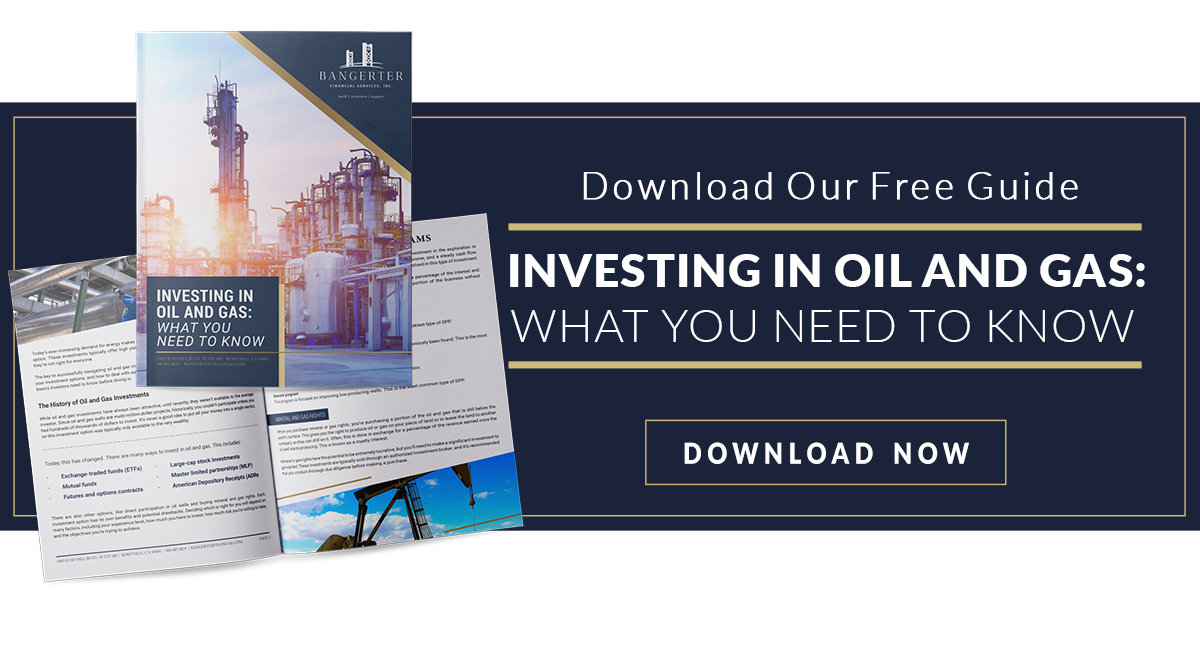Some of the most appealing aspects of oil and gas investments are the tax advantages embedded in several different types of investment programs. The oil and gas programs with the most significant tax benefits are direct participation programs (DPP), and they include:
Exploratory drilling programs (commonly known as wildcatting)
These programs involve searching for oil or gas in new unproven areas or non-producing formations. Exploratory programs are generally considered the riskiest type of oil and gas investment, but they also may provide the greatest return potential.
Developmental drilling programs
These programs are focused on drilling new wells in areas of proven reserves or where existing production occurs. Developmental programs are the most common type of DPP and are often sought out by investors seeking to take advantage of a tax write-off against their income in the same year.
Rework Programs
While generally viewed as the least common type of oil and gas investment, rework programs, when successful, can prove to be a steady source of income for investors. Rework programs focus on enhancing or revitalizing producing well where production has declined, but the opportunity to improve outputs exists. Direct participation programs allow you to invest directly in the exploration or production of oil and gas. As a result, the programs can potentially provide passive income, consistent cash flow, and meaningful tax benefits. The tax breaks can apply to upfront drilling costs as well as ongoing operations, and they generally occur in four areas:
Tangible Drilling Costs
Tangible drilling costs pertain to the actual costs of the equipment associated with drilling, which wellheads, pipelines, storage tanks, and other physical assets. Tangible drilling costs are 100% deductible but must be depreciated over seven years. The 100% deduction applies to assets placed into service before January 1, 2023, and then phases out by reducing the deduction by 20% per year over the following five years.

Intangible Drilling Costs
Intangible drilling costs include expenses other than tangible equipment and physical asset expenses associated with the drilling process. These include labor and items like chemicals, grease, and mud. Intangible drilling costs often account for as much as 75% of the well cost. The current tax code allows for a 100% deduction of intangible drilling costs in the year they are incurred.
Small Producer Tax Exemptions
Another tax incentive designed to help small producers is the depletion allowance. It excludes 15% of all gross income from oil and gas wells from taxation. The exemption only applies to entities that own, produce, or refine less than 50,000 barrels of oil per day.
Active vs. Passive Investment Structures
Since DPPs are considered to be “working interest” investments by the tax code, they are not deemed passive activity. This means any net losses are active income that can offset other forms of income like capital gains, wages, and interest. As you can see, the Internal Revenue Code extends unique tax treatments to oil and gas investments. These incentives came as a result of the OPEC oil embargo of the 1970s. Legislators designed them to spur domestic exploration and production so the U.S. could become more energy independent. In the ensuing 50 years, these tax benefits have been instrumental in expanding the growth of our domestic oil and gas industry to the point where we became a net exporter of oil only a few short years ago.
To learn more about oil and gas investment opportunities and whether they might be appropriate for you, download our free guide, Investing in Oil and Gas, What You Need to Know.
 This is for informational purposes only, does not constitute individual investment advice, and should not be relied upon as tax or legal advice. Please consult the appropriate professional regarding your individual circumstance.
This is for informational purposes only, does not constitute individual investment advice, and should not be relied upon as tax or legal advice. Please consult the appropriate professional regarding your individual circumstance.
Because investor situations and objectives vary, this information is not intended to indicate suitability or a recommendation for any individual investor.
Investments in commodities may have greater volatility than investments in traditional securities, particularly if the instruments involve leverage. The value of commodity-linked derivative instruments may be affected by changes in overall market movements, commodity index volatility, changes in interest rates or factors affecting a particular industry or commodity, such as drought, floods, weather, livestock disease, embargoes, tariffs and international economic, political and regulatory developments. Use of leveraged commodity-linked derivatives creates an opportunity for increased return but, at the same time, creates the possibility for greater loss.
Mutual Funds and Exchange Traded Funds (ETF’s) are sold by prospectus. Please consider the investment objectives, risks, charges, and expenses carefully before investing. The prospectus, which contains this and other information about the investment company, can be obtained from the Fund Company or your financial professional. Be sure to read the prospectus carefully before deciding whether to invest.
A direct participation program (DPP) is a pooled entity that offers investors access to a business venture's cash flow and tax benefits. Also known as a "direct participation plan," DPPs are non-traded pooled investments in real estate or energy-related ventures over an extended time frame.
Investment advisory services offered through Bangerter Financial Services, Inc. A state Registered Investment Advisor. Registered Representative and securities offered through Concorde Investment Services, Inc. (CIS), member FINRA/SIPC. Bangerter Financial Services, Inc. is independent of CIS.




.png?width=273&height=103&name=Brokercheck%20(1).png)

Comments